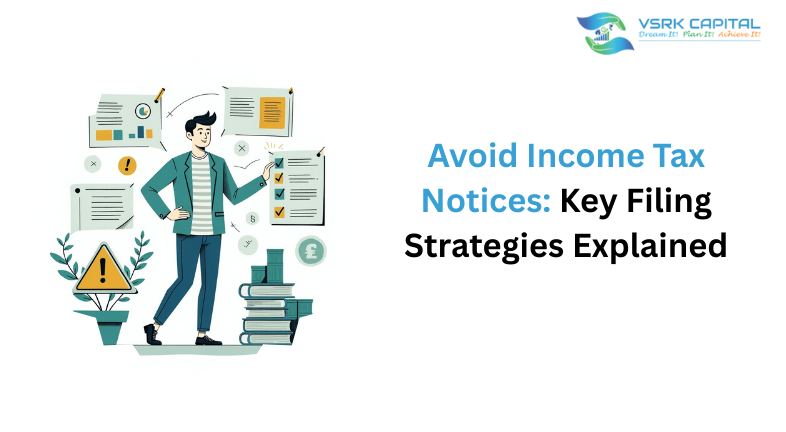
Filing your income tax return accurately and on time is more important than ever. In 2025, the Indian tax system will have become more vigilant, powered by AI monitoring and advanced data analytics. Consequently, the risk of receiving income tax notices has significantly increased.
In this blog post, we’ll explore why income tax notices are issued, highlight common ITR mistakes leading to notices, share expert strategies on how to avoid income tax notices, and show you how VSRK Capital can support your compliance needs with reliable, error-free filing.
Why Income Tax Notices Are Issued—and How You Can Avoid Them
Tax notices are typically issued when the department identifies inconsistencies or red flags. According to CBDT data (2024), over 15 lakh notices were sent to taxpayers due to mismatches in AIS and Form 26AS. With the rise in ITR scrutiny due to AI monitoring, the system now flags even minor discrepancies.
Here’s what’s triggering scrutiny in 2025:
- AI-powered monitoring and cross-checking: Returns are compared with third-party data from banks, employers, and mutual funds. Suspicious deductions or large unreported transactions are instantly flagged.
- Mismatch against AIS or Form 26AS: Missing or incorrect TDS, dividend, or capital gain entries trigger alerts.
- Defective ITR: Filing the wrong form, failing to e-verify, or omitting disclosures can render your return invalid.
- High-value transactions: Real estate deals, large deposits, or sudden bank inflows are tracked in real-time.
Tip for first-time filers: Always reconcile AIS/Form 26AS before submitting your return to file ITR correctly to avoid notices.
Common ITR Mistakes Leading to Notices
Here are the top ITR filing mistakes to avoid in 2025 that often attract income tax notices:
- Selecting the Wrong ITR Form
- Choosing an incorrect form (e.g., business income declared in a salaried form) makes the return defective under Section 139(9).
- Missing Deadlines
- Filing after the deadline (generally mid-September for FY 2024–25) results in penalties, late fees, and loss of carry-forward benefits.
- Not Reporting All Income
- Unreported income from FDs, mutual funds, rent, or freelance work is now easily tracked.
- Mismatched AIS and Form 26AS
- TDS entries or dividend details not matching cause immediate scrutiny.
- Exaggerated Deductions
- False or inflated 80C claims (LIC, ELSS, tuition fees) are easily flagged.
- Bank & E-Verification Errors
- Wrong account or IFSC delays refunds. Non-e-verification = incomplete filing.
- Foreign Income or Asset Omissions
- Failure to disclose overseas holdings results in severe penalties.
- AI-Triggered Scrutiny
- Unusually large deposits, UPI transfers, or crypto gains raise suspicion.
Pro Tip: Maintain proof of all deductions and investments. Upload receipts where required.
Case Study: When a Small Error Led to a Big Notice
Rohit, a salaried professional from Delhi, filed his return for AY 2023–24. He claimed HRA deduction but didn’t upload the rent agreement. His employer had already submitted details in Form 16, but the mismatch between AIS and his claim triggered an income tax notice.
Fortunately, Rohit corrected the filing, submitted supporting proof, and avoided penalties.
Lesson: Small documentation gaps can cause big troubles. Always double-check claims with AIS/Form 26AS to file ITR correctly to avoid notices.
How to Avoid Income Tax Notices: Best Filing Practices
Here’s a checklist of expert-approved strategies on how to avoid income tax notices:
- Cross-Verify Thoroughly: Match AIS/Form 26AS with your ITR.
- Choose the Right ITR Form: Salaried, business, capital gains—pick carefully.
- Document Deductions Properly: Keep proof for 80C, HRA, 10(14).
- File Before the Deadline: Avoid last-minute stress.
- E-Verify Promptly: Complete verification using Aadhaar OTP or net banking.
- Include All Disclosures: High-value deals, foreign assets, or directorships.
- Use Trusted Filing Support: Experts help minimise ITR filing mistakes to avoid in 2025.
Rise in ITR Scrutiny Due to AI Monitoring
The rise in ITR scrutiny due to AI monitoring is reshaping tax compliance in India. According to the Finance Ministry’s 2024 report, AI-driven systems flagged over 30% more discrepancies compared to manual review in previous years.
- Systems now cross-check across multiple yearsof filings.
- Sudden income jumps without explanation get flagged.
- Unreported crypto transactions or large digital payments are under watch.
Key takeaway: Filing correctly isn’t optional anymore—it’s mandatory for peace of mind.
How VSRK Capital Supports Your Tax Compliance
At VSRK Capital, we make sure you don’t just file, but file ITR correctly to avoid notices:
- Personalised advisory on choosing the correct ITR form.
- AIS/Form 26AS reconciliation with your documents.
- Verification of deductions, high-value deals, and disclosures.
- Timely reminders for deadlines and e-verification.
- Assistance with corrections and revised returns if needed.
With VSRK Capital, you stay safe from income tax notices while also strengthening your long-term financial strategy.
Take Action Now
Don’t risk receiving income tax notices in 2025. With tighter rules and the rise in ITR scrutiny due to AI monitoring, even small ITR filing mistakes to avoid in 2025 can trigger penalties.
Don’t wait! Start filing with VSRK Capital today—let experts help you stay compliant, accurate, and stress-free.
FAQs
Notices are issued for mismatches in AIS/Form 26AS, incorrect ITR forms, unreported income, or suspicious deductions.
Always file accurately, on time, and with proper documentation. Reconcile AIS/Form 26AS, select the right form, and e-verify promptly.
Using the wrong form, missing income sources, failing to e-verify, inflated deductions, and high-value undisclosed transactions.
AI systems compare your return with banking, salary, and investment data. Even small mismatches are flagged instantly.
We ensure error-free filing, reconciliation with AIS/Form 26AS, proper disclosures, and timely compliance to reduce risks.



